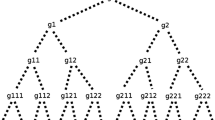Abstract
The merging/fusion of belief/data collections in propositional logic form is a topic that has received due attention within the domains of database and AI research. A distinction can be made between two types of scenarios to which the process of merging can be applied. In the first type, the collections represent preferences, such as the voting choices of a group of people, that need to be aggregated so as to give a consistent result that in some way best represents the collective judgement of the group. In the second type, the collections represent factual data that is to be aggregated with an aim of obtaining a result that maximises factual correctness. After introducing a general framework for belief merging via some prominent literature on the topic, this paper then introduces and considers a method for belief merging with the second type of scenario in mind. Its suitability is corroborated by demonstrating how it can be seen as a special case of a merging procedure that combines aggregation of probabilities and maximisation of expected truthlikeness.
Similar content being viewed by others
Notes
See Grégoire and Konieczny (2006) for a good overview.
These terms are used interchangeably.
A generalisation of the concept of a set that allows multiple instances of an element.
One can also add integrity constraints IC to the operation, such that a merge operator \(\Delta _{IC}(E)\) takes a belief profile E as input and returns a set of interpretations that satisfies IC (i.e. IC is used to denote a possibly empty set of formulas that must be logical consequences of the merging result).
These statements are used in the basic feature approach to truthlikeness Cevolani et al. (2011).
This list was expanded to nine when incorporating integrity constraints Konieczny and Pérez (2002).
\(\sqcup \) denotes the union of two profiles. Thus \(\sqcup \) is the multiset equivalent of \(\cup \) and can give results with multiple instances of an element.
As will become clearer once our formal truthlikeness measure is introduced, the narrowing down here of the result to \(w_{1}\) rather than \(\{w_{1}, w_{2}\}\) can be conducive to truthlikeness.
\(K^{x} = \underbrace{K \sqcup \ldots \sqcup K}_{x}.\)
This is known as the Tichy-Oddie truthlikeness measure in the literature.
See Clemen and Winkler (1999) for an overview.
Using the Tichy-Oddie truthlikeness measure, one or more individual states will always be amongst the datasets with highest estimated truthlikeness. In cases where there is more than one such individual state, any datasets formed as a collection of these individual states will also have this highest truthlikeness value since the truthlikeness of a collection of states is simply their average truthlikeness.
References
Cevolani, G. (2014). Truth approximation, belief merging, and peer disagreement. Synthese, 191(11), 2383–2401.
Cevolani, G., & Calandra, F. (2010). Approaching the truth via belief change in propositional languages. EPSA Epistemology and Methodology of Science, 1, 47–62.
Cevolani, G., Crupi, V., & Festa, R. (2011). Verisimilitude and belief change for conjunctive theories. Erkenntnis, 75(2), 183–202.
Clemen, R. T., & Winkler, R. L. (1999). Combining probability distributions from experts in risk analysis. Risk Analysis, 19(2), 187–203.
Eckert, D., & Pigozzi, G. (2005). Belief merging, judgment aggregation, and some links with social choice theory. In: In Belief change in rational agents: Perspectives from artificial intelligence, philosophy, and economics, Dagstuhl Seminar Proceedings 05321.
Everaere, P., Konieczny, S., & Marquis, P. (2010). The epistemic view of belief merging: Can we track the truth? In H. Coelho, R. Studer, & M. Wooldridge (Eds.), Proceedings of ECAI 2010—19th European conference on artificial intelligence, Lisbon, Portugal, August 16–20, 2010 (pp. 621–626). Amsterdam: IOS Press.
Grégoire, E., & Konieczny, S. (2006). Logic-based approaches to information fusion. Information Fusion, 7, 4–18.
Konieczny, S., & Pérez, R. P. (1998). On the logic of merging. In Proceedings of the sixth international conference on principles of knowledge representation and reasoning (KR’98) (pp. 488–498). Morgan Kaufmann Publisher.
Konieczny, S., & Pérez, R. P. (2002). Merging information under constraints: A logical framework. Journal of Logic and Computation, 12(5), 773–808.
Konieczny, S., & Pérez, R. P. (2011). Logic based merging. Journal of Philosophical Logic, 40(2), 239–270.
Machina, M. J. (2008). Non-expected utility theory. In S. N. Durlauf & L. E. Blume (Eds.), The New Palgrave dictionary of economics. Basingstoke: Palgrave Macmillan.
Niiniluoto, I. (1987). Truthlikeness. Dordrecht: D. Reidel.
Niiniluoto, I. (1998). Verisimilitude: The third period. British Journal for the Philosophy of Science, 49(1), 1–29.
Niiniluoto, I. (2011). Revising beliefs towards the truth. Erkenntnis, 75(2), 165–181.
Oddie, G. (1986). Likeness to truth. Dordrecht: D. Reidel.
Oddie, G. (2013). The content, consequence and likeness approaches to verisimilitude: Compatibility, trivialization, and underdetermination. Synthese, 190(9), 1647–1687.
Oddie, G. (2014). Truthlikeness. In E. N. Zalta (Ed.), The Stanford encyclopedia of philosophy, summer 2014 edn. Stanford University. http://plato.stanford.edu/archives/sum2014/entries/truthlikeness/
Pigozzi, G., & Hartmann, S. (2007). Judgment aggregation and the problem of truth-tracking. In Proceedings of the 11th conference on theoretical aspects of rationality and knowledge, TARK ’07 (pp. 248–252). New York: ACM.
Schmidt, U. (2004). Alternatives to expected utility: Formal theories. In S. Barber, P. Hammond, & C. Seidl (Eds.), Handbook of utility theory (pp. 757–837). Berlin: Springer.
Schurz, G. (2011). Verisimilitude and belief revision. With a focus on the relevant element account. Erkenntnis, 75(2), 203–221.
Williamson, J. (2009). Aggregating judgements by merging evidence. Journal of Logic and Computation, 19(3), 461–473.
Zwart, S. (2001). Refined verisimilitude. Dordrecht: Kluwer.
Acknowledgments
Thanks to Gustavo Cevolani for general discussion on the topic of truthlikeness and belief merging, Che-Ping Su for feedback on an early draft of this paper and Aditya Ghose for hosting a presentation of this material and providing feedback. Also, thanks to the anonymous referees who provided feedback that helped to shape this paper.
Author information
Authors and Affiliations
Corresponding author
Rights and permissions
About this article
Cite this article
D’Alfonso, S. Belief merging with the aim of truthlikeness. Synthese 193, 2013–2034 (2016). https://doi.org/10.1007/s11229-015-0825-y
Received:
Accepted:
Published:
Issue Date:
DOI: https://doi.org/10.1007/s11229-015-0825-y




